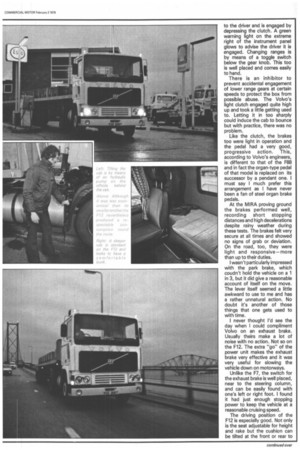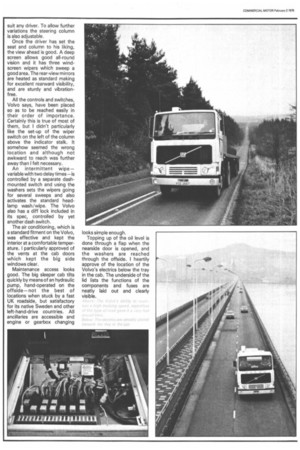On to the Mid-East without a qualm
Page 60

Page 61

Page 62

If you've noticed an error in this article please click here to report it so we can fix it.
VOLVO'S mighty F12 was clearly designed for the long-haul, Middle East type of operation, and if our road test of the vehicle round the CM Scottish route is anything to go by, it is more than a match for the job.
The most impressive thing about it is the overwhelming feeling that it can handle any situation with ease. True, our test had to be carried out at 32 tons gross and the vehicle has a design capability of 50 tons, but it really flew round the circuit.
The second day's journey — a distance of 536.9 km (333-7 miles} was completed in just over eight hours while the last day's running, consisting of some of the slowest sections of the route, took a mere seven hours eight minutes.
To put this into perspective, the B--Series ER F with a RollsRoyce 265L took half an hour longer on this stretch. However, the Volvo's power unit delivers 243 kW (326 bhp) against ERF's 1945. kW (261 bhp) and 65 extra horses make all the difference.
Surprisingly, in spite of all the available power and fast journey times, fuel consumption was more than acceptable. Overall the F12 brought in 41.2 lit/100 km (6-85 mpg) but I would guess a figure of around seven mpg would be more likely in normal use.
Just how effectively it dealt with the hills of the A68 can be seen by the time taken from Rochester to Neville's Cross and the relatively good fuel consumption on this section— nearly six mpg. It was hardly necessary to change out of high range of the sixteen-speed gearbox except for really steep and tricky gradients such as Riding Mill. For most of the hills fifth was the lowest necessary and many were cleared in sixth.
The gearbox, all-synchromesh eight-speed rangechange with an overdrive splitter, really was a pleasure to use. Overdrive is selected by a T-handle conveniently located on the dash centre console near to the driver and is engaged by depressing the clutch. A green warning light on the extreme right of the instrument panel glows to advise the driver it is engaged. Changing ranges is by means of a toggle switch below the gear knob. This too is well placed and comes easily to hand.
There is an inhibitor to prevent accidental engagement of lower range gears at certain speeds to protect the box from possible abuse. The Volvo's light clutch engaged quite high up and took a little getting used to. Letting it in too sharply could induce the cab to bounce but with practice, there was no problem.
Like the clutch, the brakes too were light in operation and the pedal had a very good, progressive action. This, according to Volvo's engineers, is different to that of the F88 and in fact the organ-type pedal of that model is replaced on its successor by a pendant one. I must say I much prefer this arrangement as I have never been a fan of steel organ brake pedals.
At the MIRA proving ground the brakes performed well, recording short stopping distances and high decelerations despite rainy weather during these tests. The brakes felt very secure at all times and showed no signs of grab or deviation. On the road, too, they were light and responsive—more than up to their duties.
I wasn't particularly impressed with the park brake, which coudn't hold the vehicle on a 1 in 3, but it did give a reasonable account of itself on the move. The lever itself seemed a little awkward to use to me and has a rather unnatural action. No doubt it's another of those things that one gets used to with time.
I never thought I'd see the day when I could compliment Volvo on an exhaust brake. Usually theirs make a lot of noise with no action. Not so on the F12. The extra "go" of the power unit makes the exhaust brake very effective and it was very useful for slowing the vehicle down on motorways.
Unlike the F7, the switch for the exhaust brake is well placed, near to the steering column, and can be easily found with one's left or right foot. I found it had just enough stopping power to keep the vehicle at a reasonable cruising speed.
The driving position of the F12 is especially good. Not only is the seat adjustable for height and rake but the cushion can be tilted at the front or rear to suit any driver. To allow further variations the steering column is also adjustable.
Once the driver has set the seat and column to his liking, the view ahead is good. A deep screen allows good all-round vision and it has three windscreen wipers which sweep a good area. The rear-view mirrors are heated as standard making for excellent rearward visibility, and are sturdy and vibrationfree.
All the controls and switches, Volvo says, have been placed so as to be reached easily in their order of importance. Certainly this is true of most of them, but I didn't particularly like the set-up of the wiper switch on the left of the column above the indicator stalk. It somehow seemed the wrong location and although not awkward to reach was further away than I felt necessary.
An intermittent wipe— variable with two delay times —is controlled by a separate dashmounted switch and using the washers sets the wipers going for several sweeps and also activates the standard headlamp wash/wipe. The Volvo also has a diff lock included in its spec, controlled by yet another dash switch.
The air conditioning, which is a standard fitment on the Volvo, was effective and kept the interior at a comfortable temperature. I particularly approved of the vents at the cab doors which kept the big side windows clear.
Maintenance access looks good. The big sleeper cab tilts quickly by means of an hydraulic pump, hand-operated on the offside—not the best of locations when stuck by a fast UK roadside, but satisfactory for its native Sweden and other left-hand-drive countries. All ancillaries are accessible and engine or gearbox changing looks simple enough.
Topping up of the oil level is done through a flap when the nearside door is opened, and the washers are reached through the offside. I heartily approve of the location of the Volvo's electrics below the tray in the cab. The underside of the lid lists the functions of the components and fuses are neatly laid out and clearly visible.




















































































































